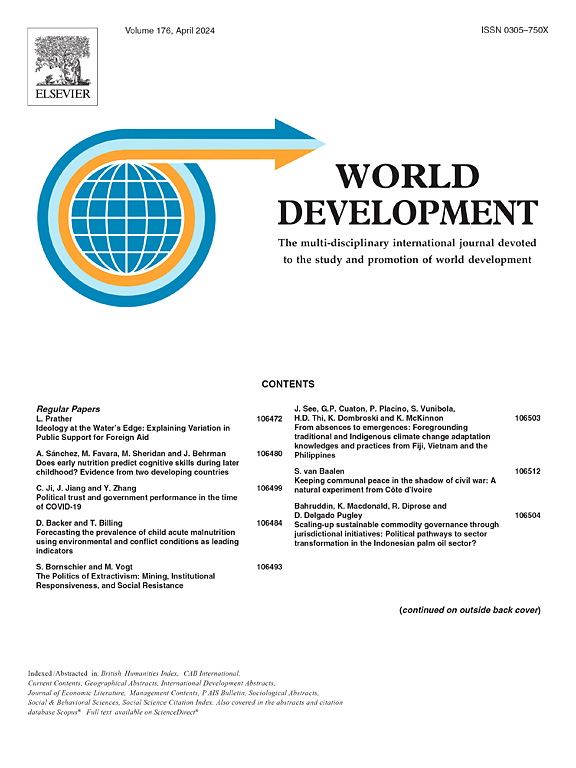罗马尼亚公共机构数字化的多维视角
IF 5.4
1区 经济学
Q1 DEVELOPMENT STUDIES
引用次数: 0
摘要
本文的目的是从三个维度来分析数字化:技术基础设施的数字化,员工及其实施变革的意愿的数字化,以及公民的数字化。选择维度的原因在于它们的重要性和相互关联性。第一个维度,技术基础设施和工具,涉及对罗马尼亚公共机构数字化技术准备情况的评估。这个维度的重点将是分析现有的硬件、软件、数据管理实践和网络安全措施,这些都是构建数字计划的基础。通过分析云采用、数据中心利用和网络安全战略的程度,这个维度揭示了成功数字化转型的关键基础。第二个维度是评估员工参与数字化转型和实施变革的意愿。为这个维度选择的框架是ADKAR(意识、欲望、知识、能力和强化)框架,它提供了管理组织变革的结构化方法。通过应用这一框架,该研究探讨了罗马尼亚公共机构如何管理对数字化转型的抵制,培养技术适应文化,并确保数字化举措的成功实施。最后,第三个维度涉及公民,评估公众的参与和参与。第三个维度探讨了罗马尼亚公共机构利用数字平台吸引公民和利益相关者的程度。该研究考察了在线门户网站、决策透明度和收集公众意见的机制。通过调查数字参与渠道的可及性、有效性和包容性,本研究旨在确定增强公民参与和促进响应性更强的治理的最佳实践。这三个方面将在一份调查表中加以落实,并将发给罗马尼亚所有市政厅。罗马尼亚有3.228个行政领土单位。在3.228个市镇中,103个市镇(包括布加勒斯特)、320个城市和2859个农村公社。受访者将被要求确定自己的角色,并回答一系列衡量三个维度(技术基础设施、员工参与数字化的意愿和公众参与度)的问题。综合这些方面的研究结果,可以全面了解罗马尼亚公共机构的数字化格局。它强调了技术准备、公民参与和有效变革管理之间的相互作用。该研究的见解有助于制定明智的战略,以优化数字化工作、改善服务提供和加强公民与政府的互动。最终,本文为政策制定者、公共管理人员、研究人员和从业者提供了宝贵的资源,帮助他们应对罗马尼亚公共部门数字化转型的复杂性。随着数字化继续塑造全球治理,了解其多方面的影响对于推动公共机构内部有意义和可持续的变革至关重要。本文章由计算机程序翻译,如有差异,请以英文原文为准。
A multidimensional perspective of digitization in Romanian public institutions
The aim of the paper is to analyze the digitalization from a three dimensions perspective: the one of the technological infrastructures, the one of the employees and its willingness to implement changes, and the one of the citizens. The reasoning behind choosing the dimensions relies in their importance and interconnectedness. The first dimension, technological infrastructure and tools, deals with the assessment of the technological readiness of Romanian public institutions for digitalization. The focus of this dimension will be to analyze the existing hardware, software, data management practices, and cybersecurity measures, the foundation upon which digital initiatives are built. By analyzing the extent of cloud adoption, data center utilization, and cybersecurity strategies, this dimension sheds light on the critical underpinnings of successful digital transformation. The second dimension deals with the assessment of employees willingness to take part in the digital transformation and to implement the changes. The framework selected for this dimension is the ADKAR (Awareness, Desire, Knowledge, Ability, and Reinforcement) framework which offers a structured approach to managing organizational change. By applying this framework, the study explores how Romanian public institutions manage resistance to digital transformation, foster a culture of technological adaptation, and ensure the successful implementation of digital initiatives. Finally, the third dimension involves the citizens and assess the public engagement and participation. The third dimension explores the extent to which Romanian public institutions leverage digital platforms to engage citizens and stakeholders. The study examines online portals, transparency in decision-making, and mechanisms for gathering public input. By investigating the accessibility, effectiveness, and inclusivity of digital engagement channels, the research aims to identify best practices that enhance citizen participation and contribute to more responsive governance.
These three dimensions will be operationalized in a questionnaire which will be send to all the city halls in Romania. In Romania, there are 3.228 administrative territorial units. Among these 3.228, 103 municipalities (including Bucharest), 320 cities, and 2859 rural communes. Respondents will be asked to identify their role and to answer a set of questions measuring the three dimensions (technological infrastructure, employee willingness to participate in digitalization, and public engagement).
The synthesis of findings across these dimensions provides a holistic understanding of the digitalization landscape within Romanian public institutions. It highlights the interplay between technological readiness, citizen engagement, and effective change management. The study’s insights contribute to the development of informed strategies for optimizing digitalization efforts, improving service delivery, and strengthening citizen-government interactions. Ultimately, this paper serves as a valuable resource for policymakers, public administrators, researchers, and practitioners seeking to navigate the complexities of digital transformation in the Romanian public sector. As digitalization continues to shape governance worldwide, understanding its multifaceted impact is crucial for driving meaningful and sustainable change within public institutions.
求助全文
通过发布文献求助,成功后即可免费获取论文全文。
去求助
来源期刊

World Development
Multiple-
CiteScore
12.70
自引率
5.80%
发文量
320
期刊介绍:
World Development is a multi-disciplinary monthly journal of development studies. It seeks to explore ways of improving standards of living, and the human condition generally, by examining potential solutions to problems such as: poverty, unemployment, malnutrition, disease, lack of shelter, environmental degradation, inadequate scientific and technological resources, trade and payments imbalances, international debt, gender and ethnic discrimination, militarism and civil conflict, and lack of popular participation in economic and political life. Contributions offer constructive ideas and analysis, and highlight the lessons to be learned from the experiences of different nations, societies, and economies.
 求助内容:
求助内容: 应助结果提醒方式:
应助结果提醒方式:


